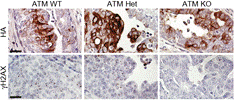Veterinary and Biomedical Sciences, Department of
Document Type
Article
Date of this Version
2006
Citation
Clinical Immunology (2006) 119: S44-S45. DOI: 10.1016/j.clim.2006.04.412.
Abstract
T-cell immunoglobulin and mucin (TIM) family Members are differentially expressed on Th1 and Th2 cells. Polymorphisms of TIM-1 have been associated with susceptibility to asthma; however, its role in regulating autoimmunity has not been studied. Here, we have used an agonistic antiTIM-1 antibody (Ab, Clone 3B3) which has previously been shown to costimulate T-cell activation and expansion, to analyze the role of TIM-1 in the development and regulation of experimental autoimmune encephalomyelitis (EAE). Treatment with 3B3 dramatically enhances the severity of EAE as well as the frequency of encephalitogenic CD4+ T-cells and the production of IFN-g and IL-17 by these cells. Furthermore, administration of 3B3 breaks self-tolerance and induces EAE in the disease resistant B10.S strain. We have utilized another anti-TIM-1 Ab (RMT1-10) that does not costimulate T-cell activation in vitro. In contrast to 3B3, treatment with RMT1-10 inhibits the development of EAE and reduces the frequency of encephalitogenic CD4+ T-cells with a commensurate decrease in the production of IFN-g and IL-17. Treatment with RMT1-10 causes CD4+ T-cells to produce more IL-4 and IL-10. We provide evidence that both 3B3 and RMT1-10 bind to the same epitope in the Ig domain of TIM-1, but the binding affinity of 3B3 is much higher than that of RMT1-10. These data suggest that TIM-1 engagement with the agonistic Ab, along with TcR ligation, costimulates T-cell expansion with pro-inflammatory IFN-g and IL-17 production resulting in the breakdown of self-tolerance and development of autoimmunity, whereas blocking anti-TIM-1 Ab causes a decrease in the autopathogenic Th1/ThIL-17 responses. This study demonstrates that TIM-1 is a key cell surface molecule that regulates effector T-cell response and depending on hopw the molecule is engaged, autoimmune responses can be either enhanced or inhibited in vivo.
Included in
Biological Phenomena, Cell Phenomena, and Immunity Commons, Medical Biochemistry Commons, Medical Immunology Commons, Medical Microbiology Commons, Medical Molecular Biology Commons



Comments
Copyright 2006, Elsevier. Used by permission.